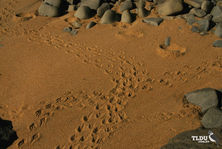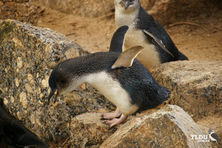
Shoppers Feedback:
Jan 17, 2017
Hello Ros,
I have now paid the invoice, but I would like to write to you just to say a big THANK YOU for getting me the Penguin!
The ChatterMate Penguin became a nice memory for me when I was in New Zealand, and I am so greatful to you for arranging so that I could have it! :-)
Thank you so much!!!!!!!!!!!
Regards,
Malin
Hi Ros,
Many thanks for your very kind email. I really appreciate your prompt reply!
I appreciate your advice regarding the decorations and customs. These are a gift for my daughter’s exchange student family so when she returns home on the weekend I will show her and see if she loves them as much as I do!
Thanks so very much again - I am truly grateful for your kind assistance.
Kind Regards
Bernadette
Ros,
Thanks again for the great customer service. It's a refreshing change!
Best regards,
Trevor
Hey Roz,
Thank you for your emails. Just loved my first order. The cute little Aussie bush critters are going to be used for an office Christmas decoration. My colleagues also liked them and talked about making an order to your site. I'll send you a photo when completed.
I'll be ordering more to send to my daughter's host family in America.
Fabulous service from you.
Kind regards,
Michelle
Thankyou. Order arrived today. One very happy grandson with his new beastly binoculars.
Regards,
Irene
- Home
- Wild Wonders
- Shop
- Aromas of Australia
- Australian Made
- Books
- Book Marks
- Christmas Decoration Sale
- Christmas Decorations
- Clocks
- Drink Holders
- Garden & Outdoor
- Gift Wrapping & Cards
- Home & Giftware
- Jewellery
- Keyrings
- New Products
- Pencils & Pen Holders
- Photo Frames
- Plush Toys
- Plush with Sound
- Sheepskin Rugs
- Stationery
- Stone Carvings
- Toys & Games
- Travel Goods
- Wedding
- Wild Figurines
- Wildlife Safety Products
- Wind Chimes
- Wine Charms
- View All Products
- Wildlife
- Australiana
- Explore
- Contact Us
Little Penguin

Quick Facts
| Length: | - |
| Height: | 33 cm |
| Weight: | - |
| Colour: | - |
| Habitat: | Temperate seas around the southern coast of Australia, Tasmania and some offshore islands |
| Food: | Fish and cephalopods and occasionally crustaceans |
| Predators: | Feral animals and dogs |
| Status: | Not Present in the NT. Secure in all other states and territories in Australia |
Like all penguins, the Little Penguin is highly adapted for life in the sea. Its body is streamlined, its wings are modified as flippers and its feathers are densely distributed over its body. The upper parts, including the back of the Little Penguin are distinctly blue, which explains one of its alternative names (Blue Penguin) and the underbelly is white. Its bill is grey-black with a pinkish lower base, and its iris pale grey to white. Young penguins are bluer than adults. The Little Penguin is also known as the Fairy Penguin because of its small size. The Little Penguin is the world's smallest penguin.
Little Penguins live along the southern edge of mainland Australia as well as Tasmania and Kangaroo Island and Granite Island just off South Australia.
Little Penguins occur in temperate seas with water temperatures between 13 degrees C and 20 degrees C. Within this region, the Little Penguin feeds mainly in inshore waters around the coast and breeding islands, and out to the continental shelf. Most breeding pairs live in colonies, although some nest on their own. Colonies are usually found on islands, with only scattered locations known on the mainland.
Adult Little Penguins are largely sedentary, returning to the colony when not at sea. Adult penguins forage for food at sea, mostly from dawn to an hour before dusk. Little Penguins swim with their flippers and use their tail for guidance. They feed on small shoaling fish and cephalopods, and to a lesser extent, crustaceans, which they capture and swallow underwater. Although several birds may pursue the same shoal, they feed singly, not cooperatively. Adult penguins may travel 14 km - 20 km per day when foraging, covering shorter distances when breeding. A foraging bird can dive from 6 m - 69 m (average about 30 m), with a sprint speed of 1.5 m/s - 2 m/s, and remain submerged for over a minute. After feeding, Little Penguins approach the colony in tight groups, remaining offshore until dusk. At dusk they come ashore, cross the beach, and head to their own burrows.
Males search for mates by advertising outside the nesting area. After pairing, calling continues at the nest site to maintain the pair bond. During courtship, both birds stand erect, with flippers spread and head bowed, and walk in tight circles around the nest site, calling loudly as they go. Little Penguins form a long-term monogamous pair bond with a separation rate of about 18%. A bird will first breed when it is two to three years old. The breeding season varies in different parts of the country:
Burrows are dug by both parents (mainly the male) to a depth of 0.15 m, with an average of just over 0.4 m. The burrow can be as far as 200 m inland and 50 m above sea level. Dunes or other soft soil are usually chosen because they are easy to dig. In some localities, a pair may use a cave or crevice in the rocks. A penguin tends to return to the same part of the same colony each year, although not necessarily to the same burrow. Both parents contribute to nest building but the majority is done by the male. The nest may vary from a thick mat of grass to a few strands, usually collected within a few metres of the burrow entrance.
The parents defend a small area around the burrow entrance. As a result, burrows are usually spaced 5 m - 10 m apart, and rarely closer than 2 m. Aggressive encounters range from posturing and calling, to fights involving pecking, shoving and slapping with flippers. Young birds wandering out of their parents' territory will be attacked by other adults.
Both parents incubate the 55 mm x 42 mm white eggs, which become stained as incubation progresses. Although there are about 68 hours between the laying of the first and second egg, both hatch together. A newly hatched chick is covered with dark grey down, which is soon replaced by a second coat, chocolate brown in colour. Their eyes are just open at one day and are fully open at one week. Feathers start to emerge at four weeks, and by eight weeks, only a few patches of down remain.
Tending of the young is shared by the parents. Just a few days after the chicks hatch, the adults alternate daily, with one parent guarding the nest and the other foraging at sea. After about two weeks, both parents go to sea each day, returning in the evening or even staying away for several days. Hungry chicks beg vigorously to be fed, pursuing their parents until their persistence drives the adults from the nest.
Little Penguins are threatened by a range of human-related activities. Colonies of Little Penguins have declined or disappeared in breeding areas altered by grazing or erosion. Other threats include oil pollution, discarded plastic products and fire. Feral animals are a considerable threat. For example rabbits have changed island habitats until these are unsuitable for penguins and predators, particularly dogs, kill many birds. In some areas, penguins are still deliberately killed for bait. The Australian population is estimated at less than 1 000 000 birds.
Last Updated: Thursday 9th January, 2014
BirdLife Australia - www.birdlife.org.au
BUSH e-TELEGRAPH
Signup for our monthly newsletter the "e-Telegraph"
Quick Links
Home | The Beginning | About The Land Down Under | Wild Wonders | Advertise on Wild Wonders | Christmas Decoration Sale | Christmas Tree Decorations | Drink Holders | Plush with Sound | Stone Carvings | Wildlife Wine Charms | Freebies | Australian Wildlife | Help Our Wildlife | Australiana | Photo of the Month | Explore The Land Down Under | Contact Us | Legal Notices


